Ticker Reports for June 3rd
Why Smartsheet Stock is an Undervalued Gem of an Investment
While Excel gives Microsoft Co. (NASDAQ: MSFT) the dominating position in data analysis and visualization software, as it is globally accepted through education and corporations, it is far from perfect. Regarding project management, platforms like Smartsheet Inc. (NYSE: SMAR) take the lead but aren’t as widely followed as other peers like Salesforce Inc. (NYSE: CRM).
Being under the radar may be a bummer for impatient investors. Still, it can also be a blessing in disguise to avoid some of the negative spotlight. Salesforce stock recently fell to a once-in-a-generation price after its quarterly earnings results, which weren’t wrong. Still, because all eyeballs fell on the stock, any figure missing expectations becomes an amplified event very quickly.
Today, investors can peg Smartsheet against other under-the-radar peers like Box Inc. (NYSE: BOX) and find out why the market is willing to place a premium valuation on Smartsheet, making its current price a level to start watching into the next quarter. Before details are discussed, though, here’s how Smartsheet fits into the technology sector.
Smartsheet’s Strategic Investment in Automation and Cloud
The world of artificial intelligence may start looking like the 2000s dot-com bubble, where stocks like Cisco Systems Inc. (NASDAQ: CSCO) made all-time highs that haven’t been able to return to nearly three decades later. This is why investors need to stay with companies that are already making a path into A.I. without unrealistic assumptions.
Smartsheet is heavily invested in automation and keeping project management in the ‘cloud,’ an area well-versed in today’s A.I. capabilities. Keeping assumptions realistic for Smartsheet, unlike a company that could promise to cure cancer through A.I. (possible, but not very likely), here are the projections investors can lean on.
Here’s what drove the Vanguard Group to invest up to $649.6 million into Smartsheet as of March 2024. Professionals tend to get into stocks they believe are cheap today relative to how much profit growth they can deliver in the future. Therefore, analyst earnings per share (EPS) 26.4% growth projections for Smartsheet can be taken seriously.
Smartsheet’s Forward P/E Ratio and Market Sentiment
Even though Smartsheet trades at only 70% of its 52-week high, trends in the mid-cap technology sector show a similar behavior. Taken as a whole, the mid-cap software as a service (SAAS) industry trades at an average of 67.5% of its 52-week high, so there’s nothing specific about Smartsheet that could have led to this bearish price action.
In fact, markets believe it could be an outlier in the pack. Using the forward P/E ratio, investors can gauge how the market feels about Smartsheet’s future earnings, and ideally, markets are willing to pay a premium for this stock over its peers.
A 26.6x forward P/E commands a premium of 76.8% over Box’s 15.1x valuation, but that’s not all. Smartsheet still calls for a 62.4% premium over the 16.4x average forward P/E multiple today compared to the rest of the software industry.
A price-to-book (P/B) ratio of 8.3x also stands 27.6% above the computer industry’s 6.5x average P/B, showing that markets like Smartsheet’s balance sheet a lot more than peers, which, of course, can be accredited to the mere 7.6% debt as total capital in the company’s balance sheet.
Young technology stocks tend to have much higher debt levels, so Smartsheet’s high debt level is a refreshing sign of stability, justifying its premium valuations.
Wall Street analysts recently lowered their price targets for Smartsheet, but they still see it going as high as $49.7 a share, calling for up to 34.5% upside from where it trades today.
Strong Financial Performance: Smartsheet’s 21% Revenue Growth
Despite recently reaching $1 billion in annualized recurring revenue, not everything is rainbows and butterflies for Smartsheet. This software's main advantage over Excel is its ability to communicate in real-time with other team members working on the same project.
However, as cool as this feature may be, Microsoft has all the resources to duplicate and improve Smartsheet’s golden ticket to the profit factory. Now, as timing in the A.I. race is of the essence, that could prove to be an opportunity.
Risky nonetheless, but still an opportunity. If Microsoft weighs out how long it would take to improve Smartsheet’s product offer and finds that it would be better to buy out the company instead, it could prove to be a very lucrative – albeit hypothetical – event for Smartsheet shareholders.
Returning to reality, more and more customers look to Smartsheet as their solution to project management. As the fiscal year 2024 results show, revenue grew 21% over the year, and operating cash flow more than tripled to reach $157.8 million, bringing Smartsheet awfully close to total profitability.
Biden to Launch "FedNOW" [Move Your Money Now]
Earlier this year President Biden signed the death warrant for America…
Executive Order 14067 will essentially cancel your money.
You see Biden and the Fed have teamed up to create a controllable, traceable, programmable digital currency to replace the dollar...
The Most Upgraded Stocks After the Q1 Earnings Season
The Q1 earnings reporting season is all but finished, with more than 98% of the reports issued. While the season unfolded largely as expected, the individual reports brought some unexpected strengths. These strengths are reflected in the analysts' activity. This is a look at the three Most Upgraded Stocks tracked by Marketbeat, where the analysts see them heading over the next few quarters, and why.
NVIDIA Regains Leadership Position
NVIDIA (NASDAQ: NVDA), a Most Upgraded Stock since early 2023, moved up several positions this quarter to regain the top spot. The company produced another record-setting quarter, outperforming estimates and raising guidance. The spectacular details include a 260% revenue gain, 500 basis points of outperformance, and 500 basis points stronger than expected guidance. The guidance may be cautious because the company is still experiencing an upswing in demand. The result is that NVIDIA stock received 49 upgrades and positive revisions in the last 90 days, most since the Q1 results were released, and they are leading the market to a new high.
The consensus price target tracked by Marketbeat has the stock fairly valued near its current levels, but there are two factors to consider. The first is that the consensus target has risen 19% since last year; the second is that recent revisions have led to a high-end range of nearly $1200 to $1400. That’s a 10% to 30% increase from current levels, and revisions are likely to continue because NVIDIA is the leader in AI and already has a clear upgrade cycle in place. The market is scrambling to get as many H100s as possible; the Blackwell series will be in demand next year, and then Rubin in 2026.
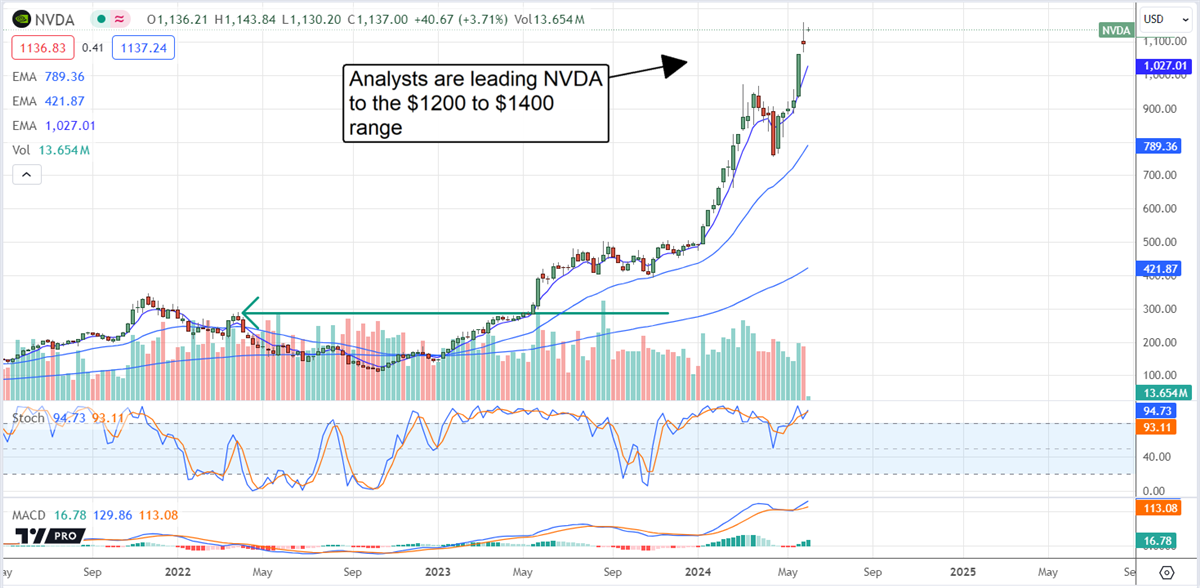
Alphabet Gains Ground: Becomes the 2nd Most-Upgraded Stock
Google parent Alphabet (NASDAQ: GOOGL) was lurking lower in the ranks at the end of calendar Q1 but has shot up the ranks following the Q1 earnings reporting season. Now in 2nd position, Google received 35 upgrades and positive price target revisions, leading the market higher. The current consensus of $191 is more than 10% above the price action and up 46% compared to last year. Much of the increase is due to the post-release activity, which increased the consensus price target by 26% and points to the high end of the range. The high target was set recently at $225 or another 2000 basis points above consensus.
Details driving the analysts' upgrade cycle include results. The company easily outpaced the consensus forecasts in Q1 on strength in all segments led by search, YouTube, and the cloud. Guidance was also increased and suggests Google’s position is secure. Demand for AI infrastructure and services is robust, and the roll-out of the Gemini chatbot is progressing smoothly.
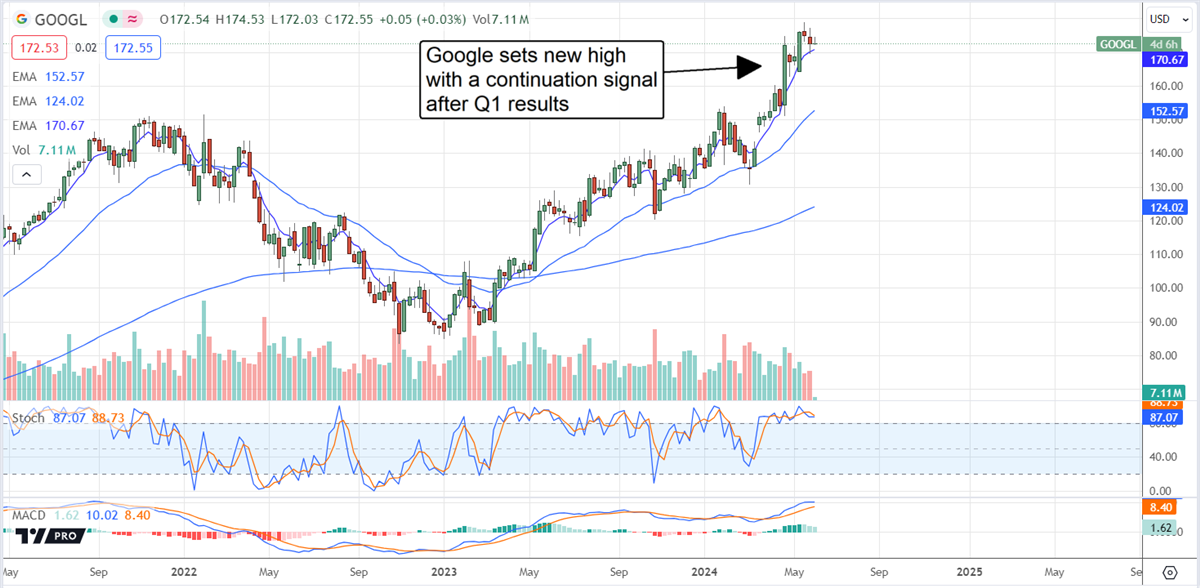
Dick’s Investors Win Big in Q1: Analysts Raise Targets
Dick’s Sporting Goods (NYSE: DKS) stock price resumed rally mode last year as analysts began to lift sentiment. The rally was reinvigorated following the Q1 results, which sparked another series of positive revisions. Details from the report include top and bottom strength, accelerating comp store sales, market share gains, wider margins, and improved guidance. The executive raised the guidance because of the results above the high-end of the prior range and the analysts' consensus forecasts.
Dick’s stock received 34 upward revisions in the last 90 days, putting it in the 3rd position on the Most Upgraded Stocks list, with an improvement of nine positions in less than 30 days. Nearly half of the revisions were issued after the Q1 release, including one upgrade and 16 increased price targets. The consensus rose by $30 or more than 1000 basis points because of the increases. Consensus assumes a 4% upside from $225, but the fresh targets put this stock in the high-end range near $260, a new all-time high worth a 15% upside.
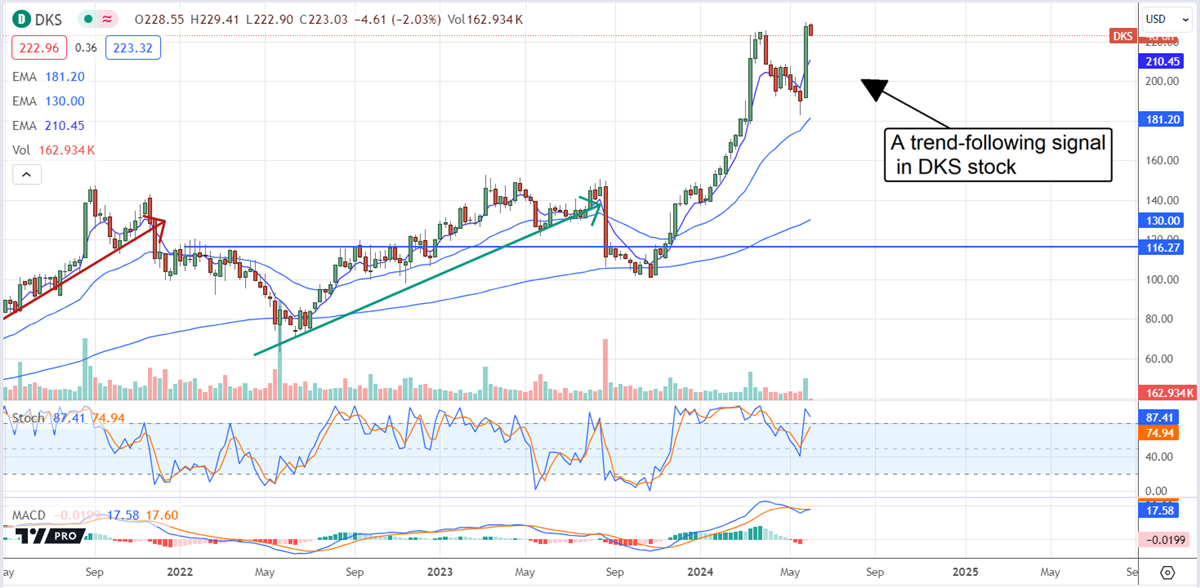
The Sneaky IRS Tax Law that's Sweeping the U.S.
In the years immediately following 2008-09, as the economy stagnated, gold exploded in value. Today, Goldman Sachs is telling its clients that gold may reach $2,250 within the next few years. Don't miss your chance to diversify your savings.
Request your info kit on gold nowWhat Is Risk Tolerance & Why Is It Important?
What Is Risk Tolerance & Why Is It Important?
Have you ever had the urge to ride the tallest rollercoaster in the park? If so, then you may have a high tolerance for risk. While riding the highest rollercoaster might not seem like a risky endeavor, it still comes with a level of anxiousness you won’t find on the kiddie rides.
Figuring out your investment risk tolerance is like figuring out how high a rollercoaster you’re comfortable riding. Some investors can tolerate massive peaks and valleys of volatility, while others prefer the market equivalent of the Merry-Go-Round. Risk tolerance is crucial because it helps develop a thorough financial strategy and prevents irrational decision-making.
The Difference Between Risk Tolerance and Risk Capacity
Tolerance and capacity are related ideas, but they describe 2 different types of responses to risk. Both need to be considered in a financial plan, so it's important to understand the nuance between the 2 concepts.
Risk tolerance measures our comfort level when putting money into markets. How does a loss make you feel? If you’re an emotional investor, you might have a low-risk tolerance since losing money could induce poor decisions. Conversely, your risk tolerance might be high if you have a calm hand during market volatility since significant losses won’t send you running for the exits.
Risk capacity measures how much capital an investor can realistically put into assets like stocks. It's not your personality at play here but your financial situation: your income, career, debt obligations and family. A single investor with a promising career has a higher capacity for risk than one with a family or a career in transition.
An investor with a low-risk capacity may still have a high-risk tolerance. For example, if you fear layoffs are coming at your company, you might cut back on investing and focus on savings, even if your heart rate is usually unaffected by losses.
How to Assess Your Risk Tolerance
What factors go into a risk tolerance assessment? Risk tolerance is a matter of personal preference. Investors with similar timelines and capital may still have wildly different views on risk depending on their personalities or life circumstances. Figuring out your risk tolerance requires some self-testing, so ask yourself the following questions:
- What are my objectives and timeline as an investor? If you’re saving for a retirement that’s still decades away, you’ll probably view risk differently than someone with a family saving for a house down payment.
- What is my current income status? If you’re a high earner and max out all your tax-deferred retirement vehicles, you probably have more capital for higher-risk investments than someone who just contributes to a 401(k).
- What is my life and family situation? As we get older, life tends to force risk tolerance adjustments. A wedding, vacation, children and the future education of those children are all significant emotional and financial events that require a personal risk re-evaluation.
MarketBeat has plenty of tools to help you start your personal risk assessment. But remember, it's crucial to be honest with yourself. Be realistic about your goals and mindset, and always consult an advisor before making big decisions.
How Risk Tolerance Influences Investment Choices
Risk tolerance looms large over the makeup of our portfolios. Investors with little appetite for risk have a portfolio composition that is much different from those who can stomach wild stock market volatility. Here are 3 basic risk tolerance examples:
Low-Risk Tolerance Investment Strategies
Investors with a conservative risk tolerance are more interested in wealth preservation than profit accumulation. Low-risk tolerance strategies are often used by retirees or older investors who prefer consistency to outperformance.
A portfolio of low-risk assets can include government or corporate bonds, dividend-paying stocks or funds in low-volatility sectors like utilities, annuities, money-market funds or FDIC-insured instruments like certificates of deposit (CDs) or high-yield savings. For most conservative investors, the key is to minimize volatility while producing steady (if unspectacular) income.
Medium-Risk Tolerance Investment Strategies
Investors can find a middle ground between high- and low-risk strategies by dividing their capital between income-producing assets and higher-volatility investments. Medium-risk tolerance investors often split their assets into two buckets: one for short-term needs and one for long-term needs. The short-term portfolio would consist of CDs, bonds or dividend-paying stocks, while the long-term portfolio is filled with growth assets like tech and consumer discretionary stocks.
The classic 60/40 stock-bond portfolio is an excellent example of a mid-range risk strategy. Investors still have more capital in stocks than bonds, which limits the upside during bull market runs. However, during market drawdowns, the bond portion should act as a buoy, keeping the portfolio afloat until the turbulence subsides.
High-Risk Tolerance Investment Strategies
Investors with high-risk tolerances typically devote most of their portfolios to stocks or derivative instruments. Volatility isn’t a bother for someone with a high risk tolerance since they often have the timeline or capital capacity to withstand drawdowns, economic trouble or earnings misses. If 60/40 is the model portfolio for medium risk tolerance, a high-risk investor will have 90% (or more) of their money in stocks.
High-risk investing doesn’t mean reckless, however. On a long timeline, stocks tend to beat other asset classes. Since 1971, average annual returns from the S&P 500 are estimated to be between 7% and 10%, depending on whether you reinvest dividends. If your timeline measures in decades, allowing risky stocks to compound can produce a substantial nest egg - just make sure you have the emotional strength to withstand bear markets.
Adjusting Risk Tolerance Over Time
Risk tolerance isn’t something you set and forget like your morning alarm clock. It morphs and evolves as your life reaches different stages. When you start your career, you have time and future earnings on your side. But as retirement approaches, timelines compress, and your expected future income can no longer be a buffer to market volatility.
Retirement is just one of many life changes that force a risk tolerance adjustment. Perhaps you marry a spouse with a lower risk appetite or pivot to a new job with a different salary. As life changes, so will your risk tolerance. Consider reviewing your investment plans every so often to ensure your risk tolerance still matches your goals and position in life.
Keep Learning with MarketBeat
Risk tolerance can be complicated since every investor has different objectives and timeframes. MarketBeat has risk tolerance assessment tools to help you start your journey. Click here to learn more about our products and offerings.



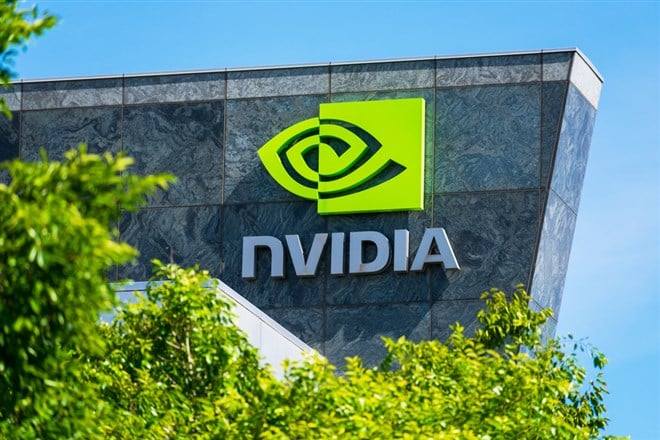

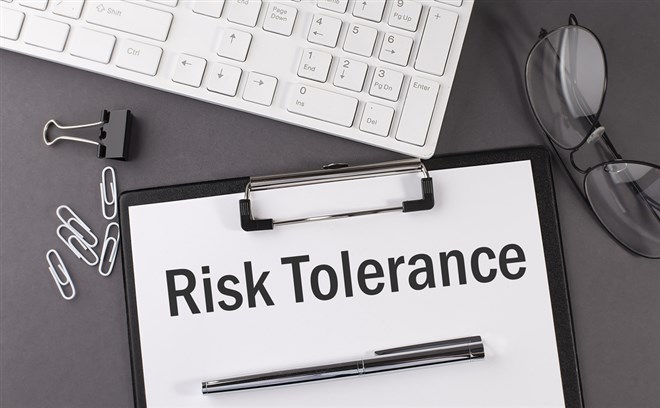
0 Response to "🌟 The Most Upgraded Stocks After the Q1 Earnings Season"
Post a Comment